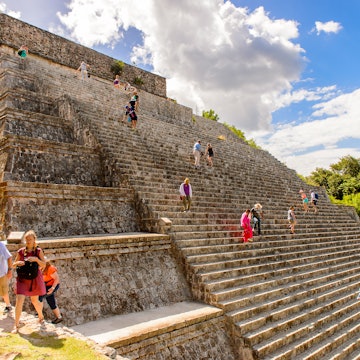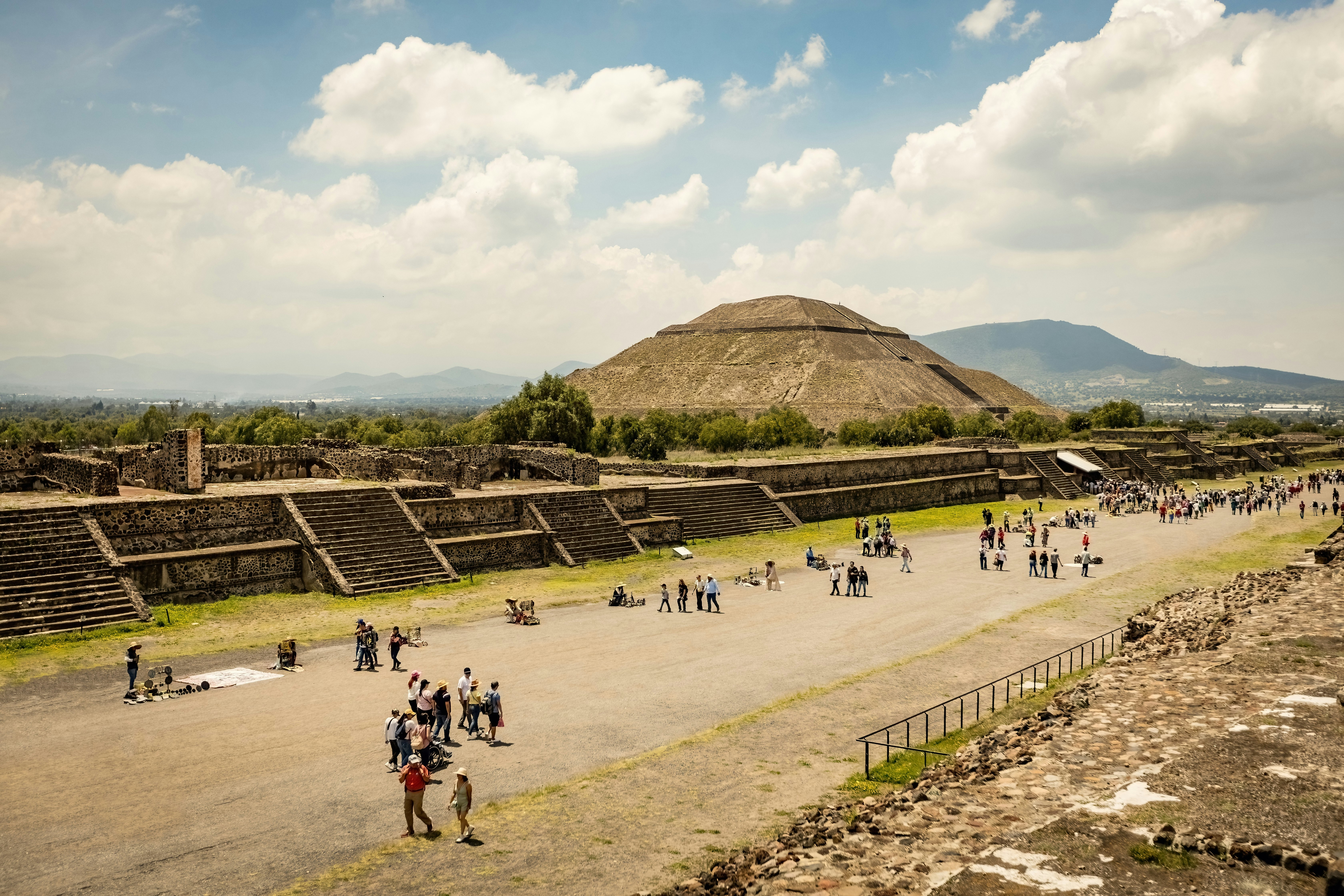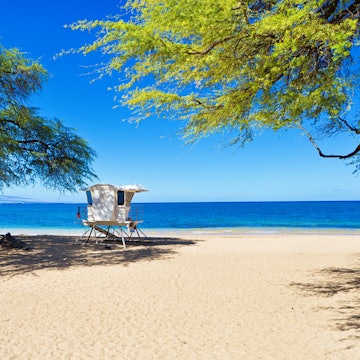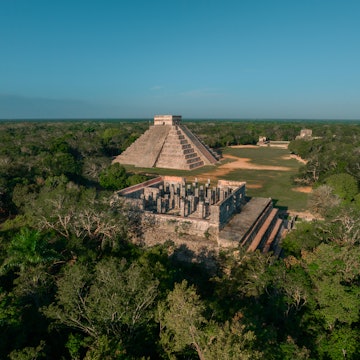

Teotihuacán, Mexico. Wirestock Creators/Shutterstock
Nothing in the Valley of Mexico region quite compares to the awe-inspiring ancient city of Teotihuacán. This complex of majestic pyramids, 50km (32 miles) northeast of Mexico City, is home to one of the most significant archaeological sites in the Americas. Its imposing structures rival the famous ruins of Yucatán and Chiapas.
The ancient city of Teotihuacán covered more than 20 sq km (8 sq mi), though most of what can be seen today is concentrated in an area of nearly 2km (1.2 miles) along the Calzada de los Muertos (Avenue of the Dead).
What’s the best way to get to Teotihuacán?
During daylight hours, Autobuses México–San Juan Teotihuacán run from Mexico City’s Terminal Central de Autobuses del Norte. Armed robberies occasionally occur on these buses, however, so it’s safer to take an Uber.
Tours are plentiful, offer better value for solo travelers and depart conveniently from Mexico City’s Zócalo. Turibús and Capital Bus run nearly identical day trips in open-top buses from the capital, and the cost includes a bilingual guide and entrance fees. Tours stop at Basílica de Guadalupe. Tour buses that include transportation and a guide can work out cheaper than making your way to Teotihuacán and hiring a guide at the entrance.

How much does it cost to visit Teotihuacán?
Admission to the park is M$100 (US$5).
What are the opening hours for Teotihuacán?
Teotihuacán opens daily from 8am to 5pm. The last admission is at 4:30pm, though you’ll want to allow at least a couple of hours to visit.

What’s the history of Teotihuacán?
Teotihuacán was once the largest city in ancient Mexico, known for its impressive pyramids and mosaics, and served as the capital of a pre-Hispanic empire. It was a hub of migration, with multiethnic groups living in segregated neighborhoods, which possibly led to its downfall – studies in 2015 suggest that cultural and class tensions caused the city’s collapse in the 8th century.
The city’s grid plan was plotted in the early part of the 1st century CE, and the Pirámide del Sol was completed – over an earlier cave shrine – by 150 CE. The rest of the city was developed between about 250 and 600 CE.
The city was divided into quarters by two great avenues that met near La Ciudadela (the Citadel). One of them, running roughly north–south, is the famous Calzada de los Muertos (Avenue of the Dead), so called because the Aztecs who arrived later believed the great buildings lining it were vast tombs built by giants for Teotihuacán’s first rulers.
The major structures are typified by a talud-tablero style, in which the rising portions of stepped, pyramid-like buildings consist of both talud (sloping) and tablero (upright) sections. These structures were often covered in lime and colorfully painted. Most of the city was made up of residential compounds, some of which contained elegant frescoes.
Centuries after the city’s fall, Teotihuacán remained a pilgrimage site for Aztec royalty, who believed that all of the gods had sacrificed themselves here to start the sun moving at the beginning of the fifth world, inhabited by the Aztec themselves.
Now a UNESCO World Heritage Site, Teotihuacán also remains an important pilgrimage site: thousands of indigenous people and New Age devotees flock here each year to celebrate the vernal equinox (between March 19–21) and soak up the mystical energies believed to converge here.

Major Teotihuacán structures
Calzada de los Muertos
The Avenue of the Dead is the main path that connects most of the sites at Teotihuacán. Gate 1 brings you to the avenue in front of La Ciudadela. For 2km (1.2 miles) heading north, the avenue is flanked by the former palaces of Teotihuacán’s elite and other major structures, such as the Pirámide del Sol. The Pirámide de la Luna looms large at the north end. Look out for the mysterious mural of a puma (or jaguar) on a wall between the two pyramids.

Pirámide del Sol
The world’s third-largest pyramid – surpassed in size only by the Great Pyramid of Giza in Egypt (which is a tomb, unlike the temples here) and the Great Pyramid of Cholula – Pirámide del Sol (Pyramid of the Sun) overshadows the east side of the Calzada de los Muertos. When Teotihuacán was at its peak (between 375 and 500 CE), the pyramid’s plaster was painted bright red, which must have been a radiant sight at sunset. While you can no longer climb up the pyramid’s 248 uneven steps due to preservation efforts, standing next to the towering structure still takes your breath away.
Palacio de Tepantitla
This priest’s residence, 500m (0.3 miles) northeast of the Pirámide del Sol, contains Teotihuacán’s most famous fresco, the worn Paradise of Tláloc. The rain god Tláloc is shown attended by priests, with people, animals and fish nearby. Above is the sinister portrait of the Great Goddess of Teotihuacán, thought to be a goddess of darkness and war because she’s often shown with jaguars, owls and spiders, which were considered underworld animals. Look for her fanged nosepiece and her shields adorned with spiderwebs.

Pirámide de la Luna
The Pirámide de la Luna (Pyramid of the Moon), at the north end of the Calzada de los Muertos, is smaller than the Pirámide del Sol but more gracefully proportioned. Completed around 300 CE, its tip is nearly the same height as the Pirámide del Sol because it’s built on higher ground. Climbing it has been banned since 2020 in an effort to preserve it.
Palacio de Quetzalpapálotl
Southwest of Pirámide de la Luna is the Palacio de Quetzalpapálotl (Palace of the Quetzal Butterfly), thought to have been the home of a high priest. The remains of bears, armadillos and other striking animals were discovered here, showing that the area was used by the elite for cooking and rituals.
Templo de los Jaguares
The Templo de los Jaguares (Jaguar Temple) and Templo de los Caracoles Emplumados (Temple of the Plumed Conch Shells) are behind and below the Palacio de Quetzalpapálotl. The lower walls of several chambers off the patio of the Jaguar Temple display parts of murals showing the jaguar god blowing conch shells and praying to the rain god Tláloc.

Templo de Quetzalcóatl
Teotihuacán's third-largest pyramid is also its most ornate. The four surviving steps of the facade (there were originally seven) are adorned with striking carvings. In the tablero (right-angled) panels, the feathered serpent deity alternates with a two-fanged creature identified as the fire serpent – bearer of the sun – on its daily journey across the sky. Imagine its eye sockets laid with glistening obsidian glass and the pyramid painted blue, as it once was.
Top things to do in Teotihuacán

Take a hot-air balloon ride over the pyramids
Seeing the pyramid complex from a hot-air balloon provides new excitement. As you gaze out across the landscape above the ancient city, dozens of other hot-air balloons in rainbow colors hang over the sun-kissed pyramids like sentinels. Your balloon passes over the Pirámide del Sol – close enough to see the steps. The pyramids were an attempt by mere mortals to recreate the might of mountains, and as your balloon jets hot air into the sky, you might feel like a deity among the mountains of Teotihuacán.
Balloon flights depart from the Municipality of Teotihuacán between 5am and 6am and typically last 45 minutes. We Fly Teotihuacán offers shared and private experiences, including pickup and drop-off from the Angel of Independence. Prices start around M$3920 (US$200).
Dine in a Cave
Set in a vast cave a short distance from Teotihuacán’s Gate 5, the Restaurante La Gruta is unapologetically gimmicky but offers a unique and kitsch eating experience. Its high ceiling means there’s little sense of being closed in, and you’ll be thankful for the cool interior after a day in the sun. The dark setting also ensures every meal is romantically lit, no matter the time of day.
The standard Mexican and pre-Hispanic fare served on clayware includes mole (chocolatey sauce on chicken), barbacoa (roast beef or lamb), tamales, tostadas de cochinita (pulled pork on crispy tortillas) and tacos, with surprisingly good escamoles (ant larvae). The menú del día (daily set menu) is the best value.
At the end of your meal, you are given a candle to place at the far depth of the cave as a nod to the ritual of rebirth performed here in the oztotl (Náhuatl word for ‘cave’) by pre-Hispanic people.
On Saturday and Sunday afternoons, there is a 40-minute folkloric dance show; reservations are recommended.

See the spring equinox
Each year at the return of spring, when the Northern Hemisphere begins to tilt back toward the sun, thousands of believers in cosmic energy dress in white and flock to Teotihuacán – here to embrace the sun’s first rays during the equinox, when energy is meant to be at its strongest. The hope is for the dawn to bathe their white clothes in red light as they dance, meditate, chant and burn incense.
Archeoastronomy – which studies ancient civilizations’ knowledge and use of the stars and other celestial bodies – has revealed that the Palace of Quetzalcóatl was a solar observatory. Even now, at the spring equinox, rays of the rising sun create a shadow upwards along red-painted owls on the wall. The bird was a symbol of stars, representing both darkness and light. At the moment of the equinox, the sun shines directly on the equator, creating equal amounts of darkness and light.
Top tips when visiting Teotihuacán
There is virtually no shade, so bring a hat or buy an inexpensive one there.
Bring snacks and water. Most eating options are mediocre restaurants catering to tour buses and are not adjacent to exits.
Do not try to climb on pyramids. Climbing was banned in 2020 to preserve the structures.
Clap your hands near the Pirámide del Sol or Pirámide de la Luna to produce echoes that mimic a quetzal’s call.
Stand by the Pirámide de la Luna and turn to face the Pirámide del Sol; you’ll notice that its silhouette replicates that of the hill behind it.















